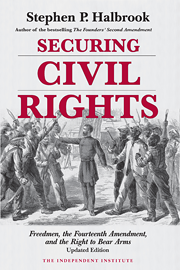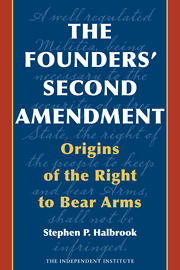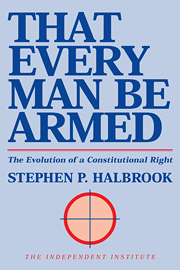Back in the 1980s, a young man and his girlfriend were driving in Alexandria, Virginia, and stopped at a federal enclave along the Potomac River for a stroll. In compliance with Virginia law, the man carried a revolver in plain sight in the truck. A Federal Park Police Officer came by, noticed the revolver, and left the immediate area to call backup. The couple returned to the truck and drove away at a normal speed, leaving the federal property.
The officer pursued the truck, turned on his flashing lights, and stopped the couple. Suddenly, two Fairfax County police cars arrived. The man and woman were pulled from the truck, thrown down on their stomachs, and handcuffed behind their backs. Officers pointed pistols and shotguns at their heads. The man was charged with possession of a firearm on park property.
I represented him in U.S. District Court in Alexandria. Judge Albert Bryan denied my motion to dismiss under the Second Amendment as “frivolous,” a not unexpected decision given Fourth Circuit precedent. In just three sentences, a 1973 Fourth Circuit decision had written off the amendment as a “collective right” somehow held only by state militias.[1] But the Fourth Amendment was alive and well—Judge Bryan ruled the arrest and seizure to be illegal because the officer was outside his jurisdiction when he arrested the defendant (who was not fleeing) and seized his firearm.
To say the least, a lot has changed since then. In 2008 in District of Columbia v. Heller, the Supreme Court held that the Second Amendment “right of the people to keep and bear arms” really does refer to the actual people and really does recognize their right to possess and carry firearms for self-defense, militia use, and hunting.[2] Heller was followed in 2010 by McDonald v. City of Chicago, which extended the right to bear arms to states and localities through the Fourteenth Amendment.[3] But because the specific law Heller invalidated was a ban on possession of handguns even in the home, the lower courts have been reluctant to recognize the Second Amendment’s protection of the right to “bear arms,” which the text of the amendment does not limit to the home, outside of the home.[4]
The Fourth Circuit’s 2011 decision in United States v. Masciandaro exemplifies this reluctance.[5] While the panel was divided on whether a right to bear arms outside the home exists, it was unanimous in upholding the conviction of a man for possessing a loaded firearm in one of the same federal enclaves along the Potomac River as in my case in the ‘80s. The déjà vu facts were just as innocuous: a man and his girlfriend were dozing in his automobile at a recreational area known as Daingerfield Island; a Park Police Sergeant noticed that the vehicle was not parked exactly right by the painted lines; asked if any weapons were in the vehicle and was voluntarily told yes; and arrested the man for possession of a loaded firearm.[6]
The decision does not reflect, as in my case, that the sergeant manhandled the couple and pointed his pistol at their heads for the “crime” of exercising Second Amendment rights. Indeed, by the time the case got to trial, the law had changed to allow carrying loaded firearms in compliance with state law.[7] One wonders what the prosecutor was thinking, other than the proverbial “batting average,” when he did not dismiss the charge for lack of prosecutorial merit.
In Masciandaro, Judge Niemeyer wrote the opinion for the court except for the critical Part III.B, which Judge Wilkinson authored and Senior Judge Duffy joined. Judge Wilkinson said that if the Supreme Court wanted to recognize the right to bear arms outside the home, the Court would have to say so more explicitly. Judge Neimeyer said that the right to bear arms exists, but, applying an intermediate level of scrutiny, the ban on possession of a loaded firearm was consistent with the Second Amendment.
In his version of Part III.B, Judge Niemeyer would have held that “there is a plausible reading of Heller that the Second Amendment provides such a right” to “possess a loaded handgun for self-defense outside the home.”[8] Indeed, there is more than a plausible reading of the Second Amendment itself to that effect, in that it provides that “the right of the people to . . . bear arms, shall not be infringed.”[9] When a provision of the Bill of Rights relates to a house, it says so.[10] Nothing in the Second Amendment’s text limits bearing arms to one’s house, a place where the right to “keep” arms fits more appropriately.
This plain textual reference prohibiting infringement on the right to “bear arms” must be respected given that “general statements of the law are not inherently incapable of giving fair and clear warning . . . .”[11] This rule exists because “broad constitutional requirements [may be] ‘made specific’ by the text or settled interpretations,” not just by the latter.[12] To disregard explicit constitutional text based on supposedly insufficient judicial precedent ignores the primacy of the Constitution and the fundamental rights it protects.[13]
As Judge Niemeyer wrote, Heller explicitly stated that bearing arms outside the home could take place for self-defense, militia activity, and hunting, which are not “home-bound” activities.[14] Heller’s statement that the need for self-defense is “most acute” in the home suggests that it may also be needed outside the home, albeit perhaps less acutely.[15] The “presumptive validity” of “laws forbidding the carrying of firearms in sensitive places such as schools and government buildings” assumes a right to carry firearms in non-sensitive places.[16] As Judge Niemeyer observed:
What the Heller Court describes as the general preexisting right to keep and bear arms for participation in militias, for self-defense, and for hunting is thus not strictly limited to the home environment but extends in some form to wherever those activities or needs occur, just as other Amendments apply generally to protect other individual freedoms.[17]
In the next part of the Masciandaro opinion, joined by the full court, Judge Niemeyer proceeded to consider the government interest in the restriction under the appropriate level of scrutiny. The Fourth Circuit had applied intermediate scrutiny to the prohibition on possession of a firearm by a person convicted of a misdemeanor crime of domestic violence.[18] That prohibition on exercise of Second Amendment rights because of a mere misdemeanor was itself unprecedented—before its passage only felons were denied such rights.
The court in Masciandaro “assume[d] that any law that would burden the ‘fundamental,’ core right of self-defense in the home by a law-abiding citizen would be subject to strict scrutiny.”[19] Limiting the core right to the home disregards that the amendment’s text refers not just to keeping, but also bearing arms, without mentioning the home at all. Carrying concealed handguns was regulated in the nineteenth century, but the decision in that period that supposedly “appl[ied] review of a decidedly less-than-strict nature”[20] found the right to carry arms to be broad indeed: “The right of the whole people, old and young, men, women and boys, and not militia only, to keep and bear arms of every description, and not such merely as are used by the militia, shall not be infringed, curtailed, or broken in upon, in the smallest degree . . . .”[21]
The court announced a policy-driven level of scrutiny because “[w]ere we to require strict scrutiny in circumstances such as those presented here, we would likely foreclose an extraordinary number of regulatory measures, thus handcuffing lawmakers’ ability to ‘prevent[ ] armed mayhem’ in public places . . . .”[22] This statement failed to distinguish the law-abiding populace (the defendant here had a Virginia concealed weapons permit, albeit expired) from those who would actually commit mayhem. Still, the court found “the application of strict scrutiny important to protect the core right of the self-defense of a law-abiding citizen in his home,” but then “conclude[d] that a lesser showing is necessary with respect to laws that burden the right to keep and bear arms outside of the home.”[23] Thus, the prohibition would be upheld if it passed intermediate scrutiny, that is, “is reasonably adapted to a substantial governmental interest.”[24]
Intermediate scrutiny, of course, is Justice Breyer’s “judge-empowering ‘interest-balancing inquiry’ that ‘asks whether the statute burdens a protected interest in a way or to an extent that is out of proportion to the statute’s salutary effects upon other important governmental interests.’”[25] The Heller majority rejected that test: “We know of no other enumerated constitutional right whose core protection has been subjected to a freestanding ‘interest-balancing’ approach.”[26]
The park in question could hardly be classified as “sensitive,” so the court saw no need to conduct that analysis.[27] Intermediate scrutiny would, as it often does, ensure the government’s victory. Naturally, “the government has a substantial interest in providing for the safety of individuals who visit and make use of the national parks . . . .”[28] Also naturally, the prohibition “is reasonably adapted to that substantial governmental interest”[29] because loaded firearms are more dangerous than unloaded ones, “as they could fire accidentally or be fired before a potential victim has the opportunity to flee.”[30] Ignoring that no record of accidents existed here, the latter comment would give incentive to law-abiding persons to carry firearms for self-defense to keep from becoming victims.
The hypothetical character of these dangers in this interest-balancing analysis ignored that the department’s regulation had been repealed and that Congress, with President Obama’s signature, had changed the law to allow the previously prohibited conduct.[31] In short, the government itself (other than the prosecutor and the court) had concluded that carrying a loaded firearm consistent with state law was not a public danger.
To be sure, unloaded firearms could be carried, and although “the need to load a firearm impinges on the need for armed self-defense,” that is okay under intermediate scrutiny.[32] But, again the Second Amendment states that “the right of the people to . . . bear arms, shall not be infringed.” That is a categorical command requiring some exception that is more than a general reference to public safety.
Judge Wilkinson,[33] joined by Judge Duffy, wrote the majority’s version of Part III.B of the Masciandaro opinion, holding that “it is unnecessary to explore in this case the question of whether and to what extent the Second Amendment right recognized in Heller applies outside the home.”[34] He explained: “On the question of Heller’s applicability outside the home environment, we think it prudent to await direction from the Court itself.”[35]
Yet McDonald could not have been plainer when it stated “our central holding in Heller: that the Second Amendment protects a personal right to keep and bear arms for lawful purposes, most notably for self-defense within the home.”[36] Regarding the First Amendment, speech that is most notably protected does not imply that other speech enjoys no protection.[37]
The Masciandaro court added that “[t]here may or may not be a Second Amendment right in some places beyond the home, but we have no idea what those places are”[38]—perhaps non-sensitive places? While resolution of such issues would be helpful to the Supreme Court in deciding cases, the Fourth Circuit decided “to await that guidance from the nation’s highest court.”[39] The policy-driven reason: “We do not wish to be even minutely responsible for some unspeakably tragic act of mayhem because in the peace of our judicial chambers we miscalculated as to Second Amendment rights.”[40] But that was the very approach rejected by Heller:
We know of no other enumerated constitutional right whose core protection has been subjected to a freestanding “interest-balancing” approach. The very enumeration of the right takes out of the hands of government—even the Third Branch of Government—the power to decide on a case-by-case basis whether the right is really worth insisting upon.[41]
Moreover, disagreeing with the policy of the Second Amendment—and thus not enforcing it—disarms potential victims and ignores that criminals do not recognize laws imposing “gun-free zones,” or indeed laws against murder. An “unspeakably tragic act of mayhem” occurred at Daingerfield Island in 2005 when a robber strangled a bicyclist to death and assaulted other bicyclists in nearby locations.[42] While not everyone would exercise the right to bear arms, and doing so is no guaranteed panacea against attack, armed self-defense can be and is successful in many cases.
There was a time in our history, at Daingerfield Island and everywhere else in the South, when only slaves were prohibited from possessing firearms.[43] Such prohibitions continued to be enforced just after the Civil War, leading the Reconstruction Congress to pass the Freedmen’s Bureau Act in 1866, which explicitly protected “the constitutional right to bear arms.”[44] During hearings that became a strong impetus for adoption of the Fourteenth Amendment, a Congressional committee heard testimony such as “attempts were made in [Alexandria, Va.] to enforce the old law against [African Americans] in respect to whipping and carrying fire-arms, nearly or quite up to the time of the establishment of the Freedmen’s Bureau in that city.”[45] Protection of Second Amendment rights from state and local infringement was a primary goal of the Fourteenth Amendment.[46]
The state courts were well aware of the meaning of the right to “bear arms” long before the Supreme Court decided Heller and McDonald. Just to cite a decision rendered in a state in the Fourth Circuit, the North Carolina Supreme Court in 1921 invalidated a ban on carrying handguns outside the home because it is “the ordinary private citizen, whose right to carry arms cannot be infringed upon,” and further:
To him the rifle, the musket, the shotgun, and the pistol are about the only arms which he could be expected to “bear,” and his right to do this is that which is guaranteed by the Constitution. To deprive him of bearing any of these arms is to infringe upon the right guaranteed to him by the Constitution.[47]
Both Heller and McDonald provide a detailed guidebook regarding the text of the Second Amendment, its original understanding, the protection of Second Amendment rights through the Fourteenth Amendment, and general guidance that the lower federal courts could utilize to develop a jurisprudence of Second Amendment rights as applied to laws not specifically at issue in those precedents. To the extent that the majority in Masciandaro eschewed ruling on—indeed, even recognizing—the right to “bear arms” pending further explicit guidance from the Supreme Court, the Fourth Circuit missed an opportunity to contribute to this jurisprudence.
[1]. “The courts have consistently held that the Second Amendment only confers a collective right of keeping and bearing arms which must bear a ‘reasonable relationship to the preservation or efficiency of a well regulated militia.’” United States v. Johnson, 497 F.2d 548, 550 (4th Cir. 1974) (citing United States v. Miller, 307 U.S. 174, 178 (1939)). However, Miller made no reference to a “collective” right, and “positively suggests, that the Second Amendment confers an individual right to keep and bear arms (though only arms that ‘have some reasonable relationship to the preservation or efficiency of a well regulated militia’).” District of Columbia v. Heller, 554 U.S. 570, 622 (2008).
[3]. 130 S. Ct. 3020, 3026 (2010).
[4]. U.S. Const. amend. II (“A well regulated Militia, being necessary to the security of a free State, the right of the people to keep and bear Arms, shall not be infringed.”).
[5] 638 F.3d 458, 460 (4th Cir. 2011), petition for cert. filed, No. 10-11212 (June 22, 2011).
[8]. Id. at 467 (Niemeyer, J., concurring).
[9]. U.S. Const. amend. II (“A well regulated Militia, being necessary to the security of a free State, the right of the people to keep and bear Arms, shall not be infringed.”).
[10]. U.S. Const. amend. III (“No soldier shall, in time of peace be quartered in any house, without the consent of the owner, nor in time of war, but in a manner to be prescribed by law.”); U.S. Const. amend. IV (“The right of the people to be secure in their persons, houses, papers, and effects, against unreasonable searches and seizures, shall not be violated.”).
[11]. United States v. Lanier, 520 U.S. 259, 271 (1997).
[12]. Id. at 267 (citation omitted). As stated in the Fourth Amendment context: “Given that the particularity requirement is set forth in the text of the Constitution, no reasonable officer could believe that a warrant that plainly did not comply with that requirement was valid.” Groh v. Ramirez, 540 U.S. 551, 563 (2004).
[13]. “This constitutional protection must not be interpreted in a hostile or niggardly spirit.” Ullmann v. United States, 350 U.S. 422, 426 (1956). “To view a particular provision of the Bill of Rights with disfavor inevitably results in a constricted application of it. This is to disrespect the Constitution.” Id. at 428–29.
[14]. United States v. Masciandaro, 638 F.3d 458, 468 (4th Cir. 2011).
[16]. Id. at (quoting District of Columbia v. Heller, 554 U.S. 570, 626 (2008)).
[18]. Id. at 469 (citing United States v. Chester, 628 F.3d 673, 677 (4th Cir. 2010)).
[21]. Nunn v. State, 1 Ga. 243, 251 (1846). This quotation was relied on in District of Columbia v. Heller, 554 U.S. 570, 612 (2008).
[22]. Masciandaro, 638 F.3d at 471 (quoting United States v. Skoien, 614 F.3d 638, 642 (7th Cir. 2010) (en banc)).
[25]. Heller, 554 U.S. at 689–90 (Breyer, J., dissenting). Justice Breyer cited intermediate scrutiny cases as embodying his proposed “interest balancing” test. Id. at 690 (citing Turner Broad. Sys., Inc. v. FCC, 520 U.S. 180, 195–96 (1997), and Burdick v. Takushi, 504 U.S. 428, 433 (1992)).
[26]. Id. at 634 (majority opinion).
[27]. Masciandaro, 638 F.3d at 473.
[31]. 36 C.F.R. § 2.4(h) (2004); 16 U.S.C. § 1a-7b(b) (2006).
[32]. Masciandaro, 638 F.3d at 474.
[33]. Judge Wilkinson previously wrote a lengthy article arguing that Heller was wrongly decided, commenting: “Roe [v. Wade, 410 U.S. 113 (1973)] and Heller share a significant flaw: both cases found judicially enforceable substantive rights only ambiguously rooted in the Constitution’s text.” J. Harvie Wilkinson III, Of Guns, Abortions, and the Unraveling Rule of Law, 95 Va. L. Rev. 253, 257 (2009); see also Nelson Lund & David Kopel, Unraveling Judicial Restraint: Guns, Abortion, & the Faux Conservatism of J. Harvie Wilkinson, III, 25 J.L. & Pol. 1 (2009).
[34]. Masciandaro, 638 F.3d at 474.
[35]. Id. at 475 (citing Williams v. State, 10 A.3d 1167, 1177 (Md. 2011), cert. denied, 2011 WL 4530130 (U.S. Oct. 3, 2011). The court in Williams said, “If the Supreme Court, in [McDonald’s] dicta, meant its holding to extend beyond home possession, it will need to say so more plainly.” Id. This author filed the petition for a writ of certiorari that was denied in that case. Petition for Writ of Certiorari, Williams v. Maryland (2011) (No. 10-1207), available at http://stephenhalbrook.com/lawsuits/Petition_cert_Williams_FINAL.pdf.
[36]. McDonald v. City of Chicago, 130 S. Ct. 3020, 3044 (2010).
[37]. “[S]peech on public issues occupies the highest rung of the hierarchy of First Amendment values and is entitled to special protection.” Snyder v. Phelps, 131 S. Ct. 1207, 1211 (2011) (internal quotation marks and citation omitted).
[38]. Masciandaro, 638 F.3d at 475.
[40]. Id. Judge Wilkinson took a less dramatic, more real-world approach in writing the opinion in Bellotte v. Edwards, 629 F.3d 415 (4th Cir. 2011), which upheld a civil rights action and rejected a police officers’ claim of qualified immunity for executing a late-night, no-knock entry into a family’s home. No indication existed that the occupants “had any tendency to violence in general. . . . To the contrary, the officers admit that holding concealed carry permits showed the Bellottes to be citizens in good standing who passed a background check.” Id. at 420. Judge Wilkinson continued: “It should go without saying that carrying a concealed weapon pursuant to a valid concealed carry permit is a lawful act. The officers admitted at oral argument, moreover, that ‘most people in West Virginia have guns.’” Id. at 423.
[41]. District of Columbia v. Heller, 554 U.S. 570, 634 (2008).
[42]. Masciandaro, 638 F.3d at 475; see also The United States Park Police advises a Homicide on Daingerfield Island, National Park Serv., http://www.nps.gov/uspp/528homdanis&arr.htm (last visited Oct. 6, 2011).
[43]. For instance, Virginia law provided that “no negroe, mulattoe, or Indian whatsoever, shall keep, or carry any gun, powder, shot, club, or other weapon, whatsoever,” except that a free negro or mulatto housekeeper may “keep one gun, . . . at frontier plantations.” 6 William Waller Hening, Statutes at Large; Being a Collection of all the Laws of Virginia from the First Session of the Legislature in the Year 1619 109–10 (1819).
[44]. McDonald v. City of Chicago, 130 S. Ct. 3020, 3040 (2010).
[45]. Report of the Joint Committee on Reconstruction, H.R. Rep. No. 39-30, pt. 2, at 21 (1866).
[46]. McDonald, 130 S. Ct. at 3038–42.
[47]. State v Kerner, 181 N.C. 574, 576, 107 S.E. 222, 224 (1921).















